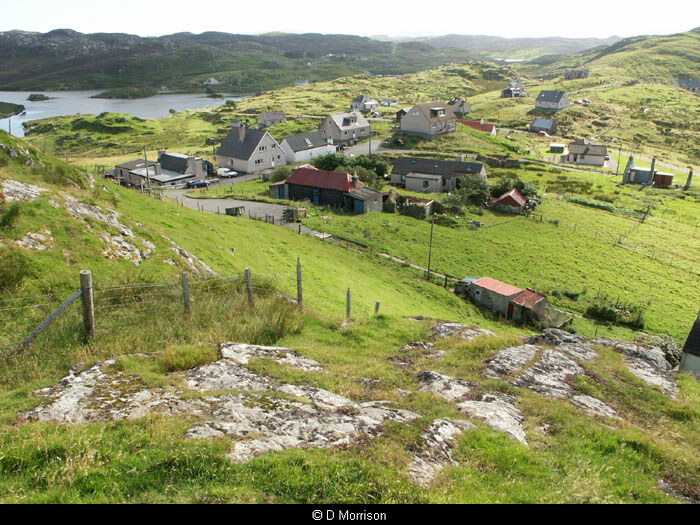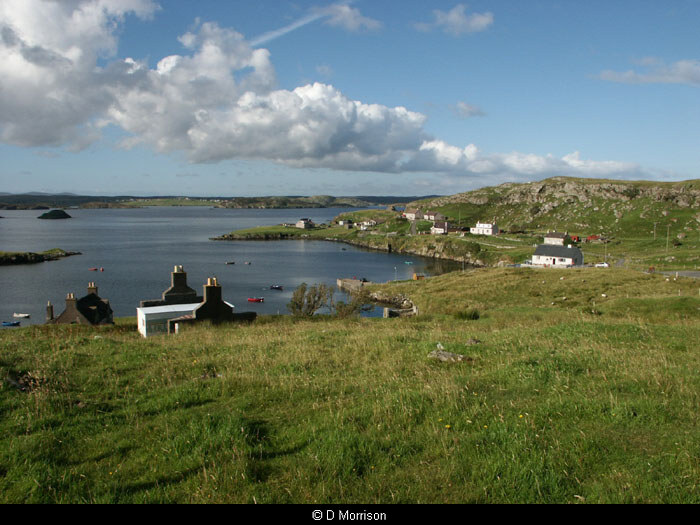43752: Cromore in 1958
A Geographical Study by Dr J B Caird and members of the Geographical Field Group 1958 G Mary Swindell BA and Dennis F Fancett BA
Cromore is situated on a peninsula between Loch Erisort and Loch Cromore. Approaching it from the access road, Cromore has the appearance of a nucleated settlement, but in fact each house is situated on the owner’s croft. The crofts are so arranged that each have a portion of land on the more level surface of drift deposits; houses 1 to 20 stand at the junction of the drift and the Lewisian gneiss. Soils are poor and thin, and there are numerous outcrops of barren rock amongst the arable land. The natural vegetation is heather moorland with extensive patches of rushes and cotton grass, the pattern of most of the ‘outrun’ around Cromore.
The township comprises twenty-seven crofts and there are twenty-seven working units; two crofts are subdivided while another four form double crofts. In addition there are five cottars and the Schoolhouse feu. Outside the township dyke there are two feus and four squatters. The croft layout differs from most other townships as each croft is in four non-adjacent pieces, one piece around the house, another above Creag Cromore and two pieces on another area of enclosed land on the common. Two crofts on the eastern side of Loch Cromore have most of their arable land around the croft-house while three crofts have only one share in the other area of enclosed land.
Until this decade all the land around the houses, and much of that above Creag Cromore, was regularly cultivated. Some of the lazy-beds on the higher land are being cut for hay this year but cultivation is limited to the land around the croft house and is completely unmechanised. The only crops at present are oats and potatoes and these are usually grown in rotation. The crofters sowed clover with their oats in 1957; the quality of most of the natural grass could be improved considerably by extending this practice. Several of the crofters have taken advantage of the facilities for obtaining lime and fertilisers, but seaweed and byre manure and widely used. Only seven crofts have vegetable plots this year but that of No 23 (partially enclosed by a dry-stone wall) has produced crops of lettuce, cabbage, turnips and carrots.
The souming for Cromore is one cow, one heifer and eight sheep per 1 rental, but is not enforced. The crofters keep the stock that they can manage to maintain throughout the winter and no one appeared to be dissatisfied with this arrangement. In fact only seven crofters exceed the souming and the total stock for the township is only 75% of the soum. Lambing takes place in April and May and often a high proportion of ewes and lambs are lost. The sheep are clipped in July and each crofter usually clips his won sheep. He either sells the fleece or has it spun in Stornoway before weaving it himself. The lambs are taken from the ewes during the second week of August and then dipped; November is the tupping period and almost every crofter had his own ram. Most crofts have a cow and a calf; the crofters like the calves to be born in March so that they are six months old in October for the Garyvard sales. An Aberdeen-Angus bull serves the cows from Crobeg Farm. The township gates are opened in October and the cattle remain within the bounds until May. An interesting regulation enforced by the Grazings Committee is that each family can have only one dog, and that it cannot be taken on to the Common Grazing without special permission, or on fank days.
Shielings, situated on the common grazing between Calbost and Cromore, were used until the 1890s. Active land use has gradually declined; in the 1920s, much of the outrun was under cultivation and from an air photograph, it is evident that hay was being taken on the strips above Cromore in 1946. The present trend is a continuing decrease in the amount of arable land but this year ten crofters formed a group to enclose and improve a ten-acre plot on the common grazing; it is unfortunate that all crofters are not willing to take part. Peats are now being cut near the road between Caversta and Gravir, about three miles south south east of Cromore and one mile north of Gravir.
Cromore was once a prosperous fishing village but now it has no fishing boats. Two Cromore fishermen work on other boats (one from Marivig and one from Stornoway and there are a few men who would welcome the opportunity to start fishing again. There seems little prospect of this, however. The landing stage, completed in 1957, is regarded by many as a white elephant and, in fact, at low tide it is useless. So much for the hopes that it might have been used by cargo vessels bringing goods to Pairc.
In Cromore there are fourteen looms for the weaving of Harris Tweed. Tweeds are obtained by road from two mills in Stornoway and one in Airidhvruach. At present, the average production is only one tweed per loom per week, but the weavers could quite easily double their production. During the past two years this industry has been comparatively prosperous. Knitting is a winter pastime but only for pleasure, although one household possesses a knitting machine.
In common with the rest of Park, Cromore has a high proportion of old people. Many from the middle age groups have sought employment on the mainland, and the teenages, many of whom have been at school in Stornoway, seek jobs there or on the mainland, returning for holidays and assisting with the croft work. Some younger folk are resident to care for aged parents.
Cromore is only eight miles by sea from Stornoway yet all communications with the town are by road – a distance of thirty two miles. There is a daily bus service and the sub-postmaster has a van which is occasionally hired. Some people recall that the only route to Stornoway was once by boat to Crossbost and thence by bus. One resident owns a lorry and this is used for most of the haulage in Cromore, particularly for bringing home peats during the summer. As a result of recent additions to the roads, only three crofts remain in accessible to vehicular traffic. There are no shops in Cromore but grocery vans call on Monday, Tuesday, Wednesday, Thursday and Saturday; butchers’ vans call on Wednesday and Friday and a fish van once or twice during the week. Goods are also conveyed by the daily bus. Electricity was brought to the village about four years ago and the inhabitants now look forward to a supply of piped water in about two years time. At present only three or four houses have bathrooms.
The crofts, when worked well, are good enough to provide the existing population with a satisfactory subsistence, but each family unit must have some additional source of income. It seems that the recent subsidies for fishing are good enough to attract fishermen from Cromore and one or two boats might be sent out from the bay if the quay were longer. Weaving has brought prosperity but, as the Park Association states in its Second Progress Report ‘there is not sufficient weaving available for the present number of weavers’. The proposal to establish a spinning and processing plant in the Park District made in the 1957 Report, would undoubtedly be of great value to the people of Cromore. The village is sited in a most picturesque spot and one of the inhabitants suggested that a hotel built on Crobeg Farm would bring some benefit to the community. However, even if these three increased sources of income became effective, one wonders whether they would be sufficient to attract the younger generation, already urbanised by schooldays spent in Stornoway.
Details
- Record Type:
- Story, Report or Tradition
- Date:
- 1958
- Type Of Story Report Tradition:
- Report
- Record Maintained by:
- CEP

